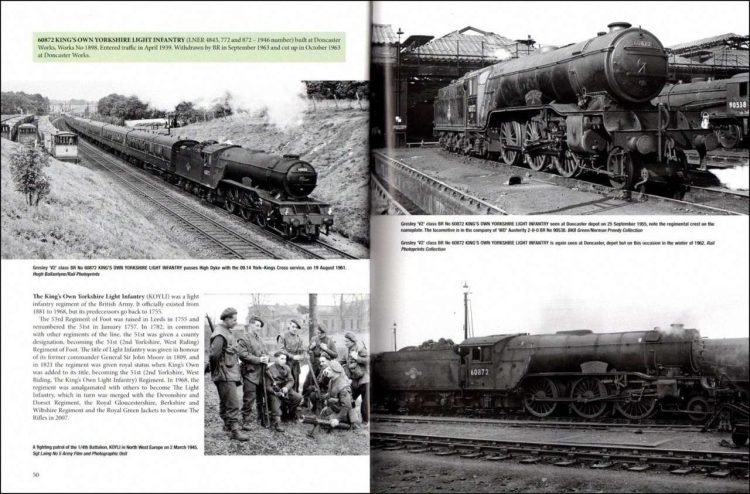This is Keith Langston's third volume about British steam with military connections, following his volumes on GWR, SR, BR & WD, and London, Midland and Scottish Railway Steam Locomotives.
Published by Pen and Sword in November 2019, this hardback book measures around 28.6 cm x 22.4 cm, has 152 pages and 150 colour and black and white illustrations. It has a published price of £25, and at the time of writing it can be obtained online from Pen & Sword for £18.75 and from Amazon for £9.99 (for the Kindle version, physical copies also available).
The book comprises a single-page Introduction that discusses the merits of naming locomotives, a chapter that groups together the classes of LNER locomotives that had named engines, and a chapter devoted to Tornado, the locomotive that has re-created A.H. Peppercorn's A1 class Pacifics, none of which were saved for preservation.
Inexplicably, there doesn't seem to be any logical reasoning behind the order in which the locomotives are described. They aren't grouped by numerical order, alphabetic grouping of class designations, or alphabetic name of designers. For example, Class B3 is followed by A4, A3, A2, then V2 and B8. In terms of designer, they correspond to Robinson, followed by Gresley, Gresley, Thompson/Peppercorn, Gresley, and Robinson, or in wheel arrangement they are 4-6-0, 4-6-2, 4-6-2, 4-6-2, 2-6-2, then 4-6-0 again.
As in the order of locomotives in this book, so also did the LNER name their V2 locomotives in a seemingly haphazard manner, such as with No. 60872 King's Own Yorkshire Light Infantry shown here.

There is also a mystery as to why none of the classes that went overseas for war service but did not carry names are mentioned. These include fifteen of the Great Central Railway's (GCR) Class 8A 0-8-0 that became LNER Class Q4 and were loaned to the Railway Operating Division (ROD) then sent to France in 1917 and returned to the GCR in 1919. The last of the class was not withdrawn until 1951.
Perhaps the biggest omission is the Great Central Railway's Class 8K 2-8-0 designed by Robinson which became LNER Class 04, 92 of which were requisitioned by the War Department in 1941 for use in support of Commonwealth forces in the Middle East, none of which came back to Britain.
Although there are 24 pages describing the Class J36 0-6-0 steam locomotives, there is no mention of the Great Northern Railway's J5 Class 0-6-0 steam locomotives, 26 of which were loaned to the Railway Operating Division during the First World War and sent to France where they saw service until 1918 when they were returned to the UK.
Another class of 0-6-0 steam locomotives not mentioned is the Great Eastern Railway's Class Y14 which became LNER class J15. During the First World War, 43 of these served in France and Belgium, with two later sold to the War Department for use on the Shropshire and Montgomeryshire Railway. Shown below is No. 65236 Horne, one of the J36s that served overseas.
Other locomotives that were sent to France during the First World War were ten North Eastern Railway Class Q5 0-8-0 Locomotives used by the Royal Engineers, all of which survived and were returned to Britain by 1920.
The book's final chapter is devoted to Tornado. With 56 pages out of the book's total of 152, this chapter gives the impression that the book is a photographic record of Tornado on the main line and on heritage railways, seeming to concentrate too much on this locomotive at the expense of the classes omitted.
The book concentrates on named engines, rather than providing an overview of all LNER locomotives that had a connection with the military. This is exemplified by the inclusion of A4 No. 60026 Miles Beevor shown below. Beevor became the chief legal adviser to the LNER, and the rather tenuous justification for his inclusion in the book is that he was a Flight Lieutenant in the Royal Air Force Volunteer Reserve.
Locomotives that obviously did have a connection with the military were the D11 Class, with Jutland and Ypres shown below, both named after famous battles of the First World War.
Compared with the author's sister volumes on GWR, SR, BR & WD Locomotives, which has 239 pages and 250 illustrations, and London, Midland and Scottish Railway Steam Locomotives, with 223 pages and 200 illustrations, the book seems frugal on both page count and number of illustrations, and does not represent particularly good value for money. It would have been better if the book had been sub-titled “Named LNER Steam Locomotives”.
In summary, the book is well laid out and the photographs are very clear and well-reproduced. One thing I liked about this book is that on the contents page are five QR codes that you can open with a mobile device to watch some video clips of locomotives in action.
Compared with the author's sister volumes on GWR, SR, BR & WD Locomotives, and London, Midland and Scottish Railway Steam Locomotives, the book seems frugal on both page count and number of illustrations, and does not represent particularly good value for money.
The book is available to purchase from Amazon and from Pen & Sword.
We would like to thank Pen & Sword for providing RailAdvent with a copy of the book for review.